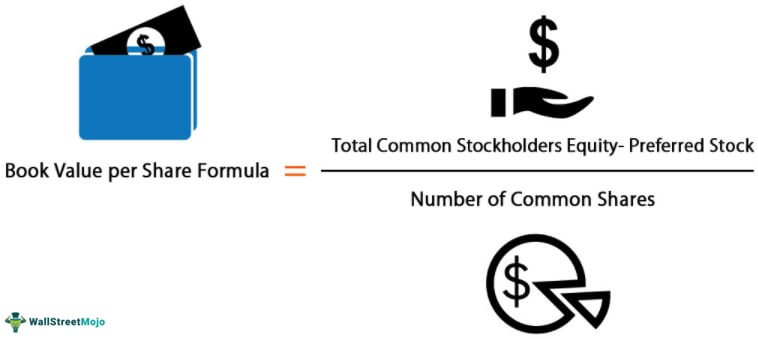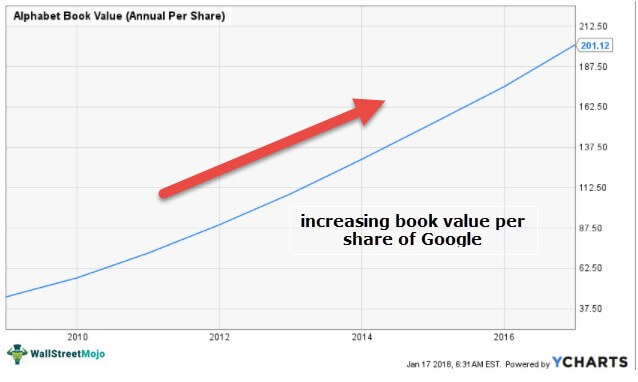What is the Book Value Per Share Formula (BVPS)?
Book value indicates the difference between the total assets and the total liabilities, and when the formula for book value per share is to divide this book value by the number of common shares.

You are free to use this image on your website, templates, etc, Please provide us with an attribution linkHow to Provide Attribution?Article Link to be Hyperlinked
For eg:
Source: Book Value Per Share Formula (wallstreetmojo.com)
Book Value per Share = (Total Common Stockholders Equity – Preferred Stock) / Number of Common Shares
Table of contents
Key Takeaways
- The “Book Value Per Share formula” calculates the value that each outstanding common share holds by dividing the total book value by the number of common shares.
- The book-to-market ratio serves as a valuable tool for assessing equity. It entails a comparison between the market value of equity and either earnings or book value.
- When determining the book value per share, begin by subtracting the preferred stock from the shareholders’ equity to ascertain the equity accessible to common stockholders. Following this, divide the resulting figure by the total number of common shares outstanding.
Explanation
The above book value per share formula has two parts.
The first part is to find out the equity available to the common stockholders. You may ask why we deduct the preferred stock and average outstanding common stock. We deduct preferred stock from the shareholders’ equity because preferred shareholders are paid first after the debts are paid off.
- Book Value = Shareholders Equity – Preferred Stock
- And Shareholder’s equity = Total Assets – Total Liabilities.
The second part divides the shareholders’ equity available to equity stockholders by the number of common shares.
In the below graph, we see the book value of Google for the past ten years. The book value of Google in 2008 was $44.90 per share and had increased by 348% to $201.12 per share by the end of 2016.

Financial Modeling & Valuation Courses Bundle (25+ Hours Video Series)
–>> If you want to learn Financial Modeling & Valuation professionally , then do check this Financial Modeling & Valuation Course Bundle (25+ hours of video tutorials with step by step McDonald’s Financial Model). Unlock the art of financial modeling and valuation with a comprehensive course covering McDonald’s forecast methodologies, advanced valuation techniques, and financial statements.
Book Value, Face Value & Market Value – Video Explanation
Example
Let’s take a simple book value per share example –
UTC Company has the following information –
- Total assets at the end of the year – $150,000
- Total liabilities at the end of the year – $80,000
- Preferred Stock – $20,000
- Number of common shares – 2000 shares
Our job is to find out the book value of UTC Company.
The first part of our calculation would be to find out the total shareholders’ equity available to common shareholders and preferred stockholders.
To do that, we need to use the following formula.
- Shareholders’ Equity = Total Assets – Total Liabilities;
- Or, Shareholders’ Equity = $150,000 – $80,000 = $70,000.
We need to calculate how much shareholders’ equity is available to the common stockholders.
We need to deduct the preferred stocks from the shareholders’ equity to do that.
- Shareholders’ equity available to common stockholders = Shareholders’ Equity – Preferred Stock
- Or, Shareholders’ equity available to common stockholders = $70,000 – $20,000 = $50,000.
We need to divide the shareholders’ equity available to common stockholders by the number of common shares.
- Book Value per share formula of UTC Company = Shareholders’ equity available to common stockholders / Number of common shares
- BVPS = $50,000 / 2000 = $25 per share.
Uses of BVPS
Investors need to look at both the book value and market value of the share. If the investors can find out the book value of common stocks, they will be able to figure out whether the market value of the share is worth it.
For example, if the BVPS is $20 per share and the market value of the same common share is $30 per share, the investor can determine the ratio of price to book value as = Price / Book Value = $30 / $20 = 1.5.
At the same time, we use book value in the case of the ROE formula when we calculate the ROE per share.
If we look at the ROE per share formula, we would be able to understand it –
ROE per share = Net Income per Share / Book Value per Share
Here, net income per share is also called EPS.
Book value Per Share Calculator
You can use the following Book value per Share Calculator
| Total Common Stockholders Equity | |
| Preferred Stock | |
| Number of Common Shares | |
| Book Value per Share Formula = | |
| Book Value per Share Formula = |
|
|
Book Value Per Share in Excel (with excel template)
Let us now do the same Book value per share calculation above in Excel. Here you need to provide the four inputs Total Assets, Total liabilities, Preferred Stock, and Number of common shares.
You can easily calculate the book value in the template provided.
To do that, we need to use the following formula.


Next, we need to calculate how much shareholders’ equity is available to the common stockholders.
To do that, we need to use the following formula.


We need to divide the shareholders’ equity available to common stockholders by the number of common shares.


You can download this Book Value Per Share excel template here – Book Value per Share Excel Template.
Book Value Per Share Video (formula for book value per share)
Frequently Asked Questions (FAQs)
The book value per share formula is relevant as it assesses the net value of a company’s assets after liabilities, providing insight into its financial health and true worth on a per-share basis. It aids investors in evaluating whether a stock is undervalued or overvalued based on its intrinsic value.
A good book value per share varies by industry, but generally, a higher value indicates a company’s assets exceed liabilities, suggesting a potentially stronger financial position. Comparing it to the stock price helps determine if a stock is trading at a reasonable value.
Applying the book value per share formula offers several benefits. It assists in assessing a company’s solvency aiding investment decisions. It helps identify value stocks and potential bargains. Additionally, it offers insights into a company’s financial stability, influencing long-term investment strategies.
Recommended Articles
This article has been a guide to the Book Value Per Share formula. Here we discuss how to calculate BVPS step by step and practical examples and excel templates. You may also have a look at these articles below to learn more about Financial Analysis –

